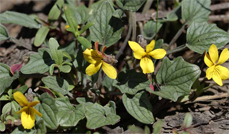 Viola pinetorum is a species of violet known by the common names goosefoot violet, goosefoot yellow violet, gray-leaved violet, or mountain yellow violet. It grows exclusively in mountain ranges in California, including the San Gabriels and the San Bernardino Mountains in San Bernardino County, as well as in Riverside, Alpine, El Dorado, Fresno, Inyo, Kern, Los Angeles, Madera, Mariposa, Placer, Sierra, Tulare and Ventura counties.
Viola pinetorum is a species of violet known by the common names goosefoot violet, goosefoot yellow violet, gray-leaved violet, or mountain yellow violet. It grows exclusively in mountain ranges in California, including the San Gabriels and the San Bernardino Mountains in San Bernardino County, as well as in Riverside, Alpine, El Dorado, Fresno, Inyo, Kern, Los Angeles, Madera, Mariposa, Placer, Sierra, Tulare and Ventura counties.
The gray-leaved violet occurs in various types of mountain habitat, including forests, embankments and talus, which is a collection of broken rock fragments at the base of crags, mountain cliffs, volcanoes or valley shoulders that has accumulated through periodic rockfall from adjacent cliff faces. Talus deposits typically have a concave upwards form, while the maximum inclination corresponds to the angle of repose of the mean debris size. Talus, also referred to as scree, is also commonly formed as the consequence of water turning to ice within mountain rock slopes, creating new cracks through a continuous freeze-thaw-freeze cycle from day-to-night-to-day-to-night, most commonly in spring and fall.
This herb grows from a tough taproot and produces erect or decumbent stems that are singular or multiple and clustered, up to nine inches long, with subterranean caudices from woody rhizomes. The simple leaves are linear to oval in shape with pointed tips and toothed edges. The longest ones reach six to eight inches in length and are basal with one to four per caudex. A solitary flower is borne on a long, upright stem. It has five deep yellow petals, the lowest three veined with brownish purple, and the upper two with brownish purple coloring on the outer surfaces. The fruit is 3.5 to 7 millimeters in width, ovoid and covered with downy hairs. The seeds are 3.5 millimeters of a medium brown color. The seeds are mildly toxic.
From Wikipedia and www.calflora.org
SBCSentinel
News of note from around the largest county in the lower 48 states.
